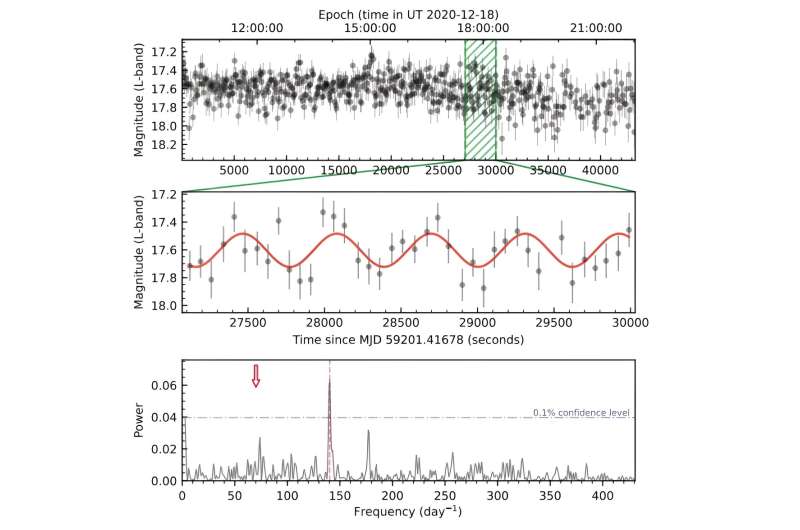January 2, 2024 report
This article has been reviewed according to Science X's editorial process and policies. Editors have highlighted the following attributes while ensuring the content's credibility:
fact-checked
preprint
trusted source
proofread
New ultra-short period binary discovered

Using the Tsinghua University–Ma Huateng Telescopes for Survey (TMTS), an international team of astronomers has discovered a new binary known as TMTS J052610.43+593445.1. The newfound system is an ultrashort-orbital-period binary consisting of a subdwarf star and a white dwarf companion. The finding was reported in a paper published December 21 on the preprint server arXiv.
According to binary evolution theory, the second common envelope ejection can produce low-mass B-type subdwarf (sdB) stars inside ultrashort-orbital-period binaries. The orbital periods of such detached sdB binary systems can be as short as 20 minutes. However, to date only four binaries of this type with orbital periods below one hour have been found.
Now, a team of astronomers led by Jie Lin of the Tsinghua University in Beijing, China, reports the detection of a new sdB binary with an extremely short orbital period. They employed TMTS to search for unusual short-period objects in our Milky Way galaxy. As a result, they discovered a dozen such objects, and one of them, which received designation TMTS J052610.43+593445.1 (or J0526 for short) turned out to be an sdB binary with an orbital period of approximately 20.5 minutes.
Lin's team found that J0526 consists of a visible sdB star (designated J0526B), about seven times larger than the Earth, with a mass of approximately 0.33 solar masses, which is being tidally deformed by an invisible carbon–oxygen white dwarf companion (J0526A).
The observations indicate that the white dwarf is about 10 times smaller than the sun, has a mass of about 0.735 solar masses, and its effective temperature is 25,400 K. The system has an orbital period of approximately 20.506 minutes and is estimated to be located some 2,760 light years away from the Earth.
The astronomers assume that the J0526 system is currently detached. They predict that after about 1.5 million years, J0526B will overflow its Roche lobe and transfer mass toward J0526A at an orbital period of around 14 minutes. This will lead to the formation of an AM CVn star through the helium-star channel.
The researchers noted that J0526B will begin a transition to a degenerate state, which may lead to the formation of a helium-core white dwarf. They added that when the electron-degeneracy pressure becomes dominant, J0526B will reach the minimum orbital period of about nine minutes and it will start to expand with its mass loss. This will probably lead to an increase in orbital period as predicted by binary evolution theory.
Summing up the results, the authors of the paper underlined that J0526 could be the shortest-orbital-period single-degenerate detached binary. Further studies of this system could be essential for the investigation of binary evolution paths from the second common envelope ejection to the formation of AM CVn stars.
More information: Jie Lin et al, A seven-Earth-radius helium-burning star inside a 20.5-min detached binary, arXiv (2023). DOI: 10.48550/arxiv.2312.13612
Journal information: arXiv
© 2024 Science X Network




















